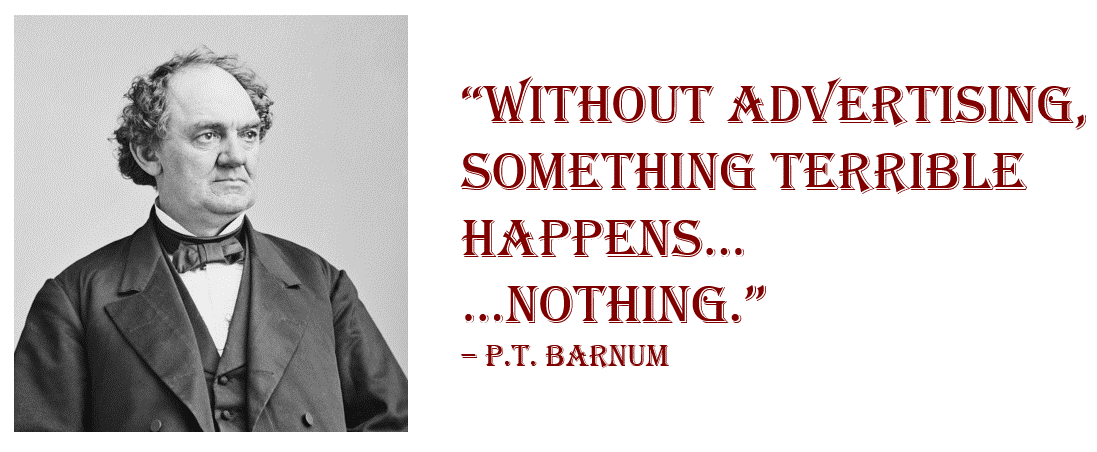
I wish I could remember where I first saw this quote. It may have been tacked up on a sales cubicle or in an ad agency. But I remembered thinking at the time, it was a smart quote no matter what was going on – a new product launch, a recession, even a global pandemic.
I later learned its source was none other than Phineas Taylor Barnum (P. T. to you), also known as “The Greatest Showman on Earth.” After all, when you’re credited with creating the biggest, most successful circus on planet earth, that’s something. For those of us who have worked in radio stations that have often felt like a circus, it’s easy to relate to what Barnum pulled off. He is known for hoaxes, stunts, and other attention-getting tricks that kept crowds coming back to “the big top” for decades and decades.
In the radio business, it’s the very rationale account executives are taught to espouse. When clients claim they’re out of budget or they advertised last quarter and “it didn’t work,” that’s when the radio seller snaps off the Barnum quote.
And through the first half of my radio career, most of the broadcasters I worked for – and later consulted – walked that walk. They advertised – year after year – at least in the spring and fall books. A handful were disseminating their brand messages and promotions pretty much 52 weeks a year. When I worked for ABC Radio in the ’70s, you could almost always convince a boss somewhere to spend some money on a marketing opportunity that could build the brand and maybe even move the needle.
Back in 1978, in just a matter of weeks after one of these conversations, our team at WRIF saw The Loop’s “Remarkable Mouth” spot, selected the model, flew to L.A., cut the spot, and then let the campaign do its thing. Not only did it work for the Spring Book, it changed the course of the brand’s arc. It helped make the station the center of attention in a hot media market. And now, RIFF is a 50+ year station – in the same format, near the top of the heap in the ratings year after year.
course of the brand’s arc. It helped make the station the center of attention in a hot media market. And now, RIFF is a 50+ year station – in the same format, near the top of the heap in the ratings year after year.
Was it the marketing? Of course not. But annual advertising campaigns told the brand story to the station’s key constituents – audience, advertisers, and the community. And the great ads helped further the narrative as a fun, irreverent station.
And ABC wasn’t alone. Most companies back then emulated that same mindset – CBS, Viacom, Cox, NBC, along with smaller companies aspiring to do big things – Hubbard, Susquehanna, Saga, and so many others. Do not market – especially during a “big book” – was tantamount to not being competitive. After all, we had to maintain those cume levels, and of course, our TSL was dependent on marketing efforts. And the advertisers were paying attention, too. If your station was sitting out a book, people took notice – like a sports franchise not taking part in free agency. Doing nothing made a statement – and not a good one.
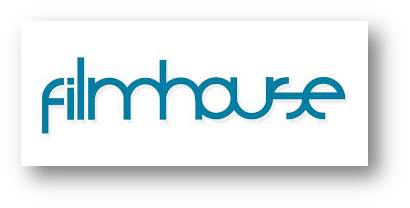 TV production companies – for radio – were everywhere. Filmhouse in Nashville – the home of “The Birthday Game” – was one of the biggest. It was common for stations to fly a small team to their studios to cut spots for the upcoming spring or fall campaigns. But there were others – Superspots, Steve Stockman, Chuck Blore, and other outfits that competed hard to come up with the hot spot of the year for radio.
TV production companies – for radio – were everywhere. Filmhouse in Nashville – the home of “The Birthday Game” – was one of the biggest. It was common for stations to fly a small team to their studios to cut spots for the upcoming spring or fall campaigns. But there were others – Superspots, Steve Stockman, Chuck Blore, and other outfits that competed hard to come up with the hot spot of the year for radio.
Here in Detroit, we did a lot of work with a brilliant agency pro, Chato Hill. He wrote and produced many of the original Classic Rock campaigns that ended up “going national” back in the ’80s and early ’90s.
Outdoor campaigns were common, too, often crafted locally by hometown agencies. But creative types like the late Steve Heckman out of Grand Rapids could take any current event or infamous celebrity and turn it into a buzzworthy billboard for a local radio station. His campaigns were attention-getting, often ending up on local TV stations for stirring up the commuting population. And because Heckman was fast, he could often have a board ready to go in a day or so, while an issue, headline, or scandal were still hot.
it into a buzzworthy billboard for a local radio station. His campaigns were attention-getting, often ending up on local TV stations for stirring up the commuting population. And because Heckman was fast, he could often have a board ready to go in a day or so, while an issue, headline, or scandal were still hot.
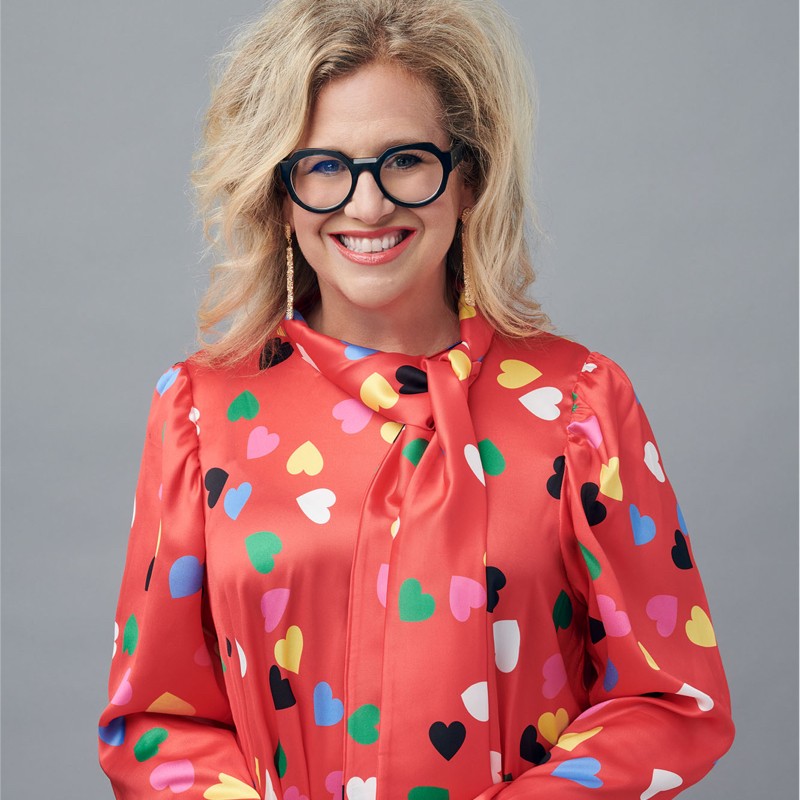
All this talk about marketing hit me when I read a profile of newly minted Chief Marketing and Communications Officer for United Parks & Resorts, Marisa Thalberg (pictured). Having spent time in similar positions for Taco Bell and Lowe’s, Thalberg is about to tell a new marketing story for SeaWorld.
Like a lot of heritage entertainment brands, SeaWorld’s been around for a long time – 60 years to be exact – like a lot of radio stations. The new campaign, “So Many Worlds To Love,” takes the viewer on a walk-through of the park with a family.
It’s one thing to launch a new theme park…or radio station. But how do you provide a fresh narrative for a brand everyone thinks they already know or have experienced?
Like radio, SeaWorld markets constantly, but not in what she refers to as a “higher-order story” addressing the brand experience. And just like radio, SeaWorld has had some tough going as a brand, especially all those stories about how they ran breeding programs, orca deaths, and other well-publicized incidents with both trainers and guests at the park.
That’s where the art of marketing comes into play. Broadcast radio – like any brand – has its share of stories and even failures we’d just as soon forget. And the industry is constantly under fire by critics who proclaim the death of the medium. Some of the loudest voices come from within our industry.
Great marketers know it’s about both spin and storytelling. Thalberg doesn’t talk about SeaWorld’s past or its fails – some of which have been both tragic and epic. She focused SeaWorld’s new conversation about family experiences in a year when many families are seeking precisely that.
As she explains to Chief Marketer, “There will always be an art to great storytelling. Why? Because we’re still always fundamentally human. Being a marketer means… thinking about all the levers and drivers and the complicated decision journeys we all make in our heads. The great thing about marketing is you get to play with all that, with the psychology, business and culture. And when it works, it’s exhilarating.”

That is, when you get that chance to pull those levers and push those buttons. In radio, most marketing and promotion persons haven’t even had the chance to even take the wheel, aside from working with street teams and other client fulfillment activities.
As Steve Heckman had the gift of coming up with that perfectly (in)appropriate campaign at just the right time, Thalberg has watched her risk-taking strike gold – and also go belly-up. But as that old ringmaster reminds us, if you don’t advertise, nothing happens.
What happens when brands stop marketing? Ehrenberg-Bass, market scientists, conducted an extensive study in 2018. Their report is loaded with charts like this one:
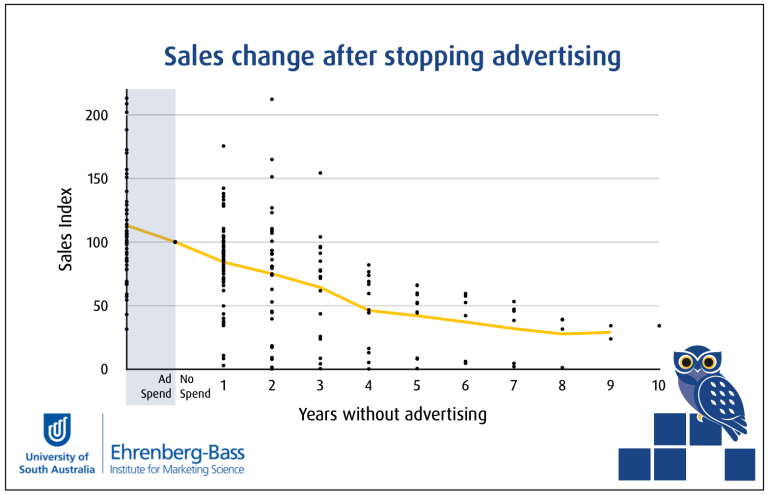
Because it’s been so long in radio when stations consistently marketed, it’s easy to forget how marketing and opportunity work together. Prior to her current position, Marisa Thalberg joined Lowe’s just before the pandemic. With the world sitting at home, dreaming of home improvement and DIY projects, Thalberg turned out to be the right CMO at the right time.
For SeaWorld, the situation is similar, but different. Now that COVID is in the rearview mirror, families are excited to travel together and experience new family adventures. Thalberg looks to turn the spotlight of the story on “the hero” – in SeaWorld’s case, through the eyes of the family and its individual members.
Like in radio, it is about the connection between the station and the community, the morning show and the commuter, the brand and what it can do for advertisers and sponsors. And of course, timing IS everything. But so is having both the capital and the freedom to strike quickly, deftly, and artfully.
As I talked about in yesterday’s post – “Does Your Radio Station Give Your Listeners ‘The Feels?'” – with brands that move you,” SeaWorld marketing isn’t about how many orcas you’ll see or the fun rides you’ll take or the food you’ll eat along the way.
It’s how visiting the park with your family will make you feel.
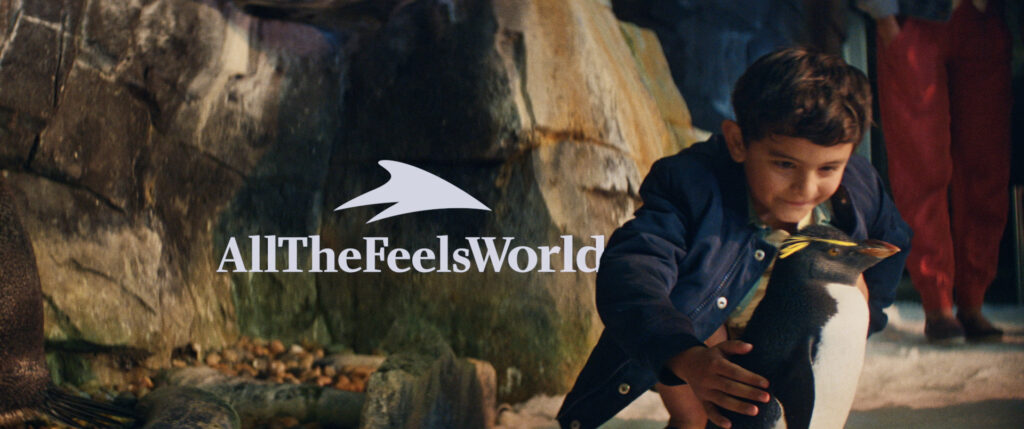
If Thalberg did her homework, designed a well-executed campaign, and gets lucky (that is, no disasters in any of the three SeaWorld locations this year), her facelift for SeaWorld might just end up being a success.
But what about broadcast radio in America? It could use a new narrative, a hero story, a little cosmetic surgery right about now. In a world of subscription fees, algorithms, and bots, local radio has a story to tell.
Of course, there’s no money? How on earth could the radio industry afford $5 million or more to do a little marketing for itself, availing itself of a real agency and a marketer like Marisa Thalberg?
This is where we have to get creative. So here are two avenues, call them crazy or come up with something better:
- Billboards forever – Every broadcast radio station in America kicks in $100 for the creative and then buys one billboard for one month. Think of it – if there are 30 stations in the market, there’s now a campaign filled with 30 boards, sufficient to cover a medium market with ease. Of course, the boards have to be consistent, advertising a unified message.
- The radio tax – Here we are on the verge of Tax Day in America. So imagine stations in the top 25 markets kicked in $2,500 each, in 26-50 it’s $2,000, and in 51-100, it’s $1,500 a station. In markets 101+, the tax is $500/station. A little back-of-the-napkin math nets this out to well more than $8.6 million – more than enough to hire a professional marketer, agency, and get that message out there.
Crazy? Impossible? OK, put on that creative hat, grab your own napkin, and come up with a better way.
And thinking about the opening question, “When did radio stop advertising?” I peg it right around the mid-’90s when consolidation happened and many owners reasoned they no longer had to advertise because they “owned the market.” If we chart the last two decades when station marketing has become the anomaly, not the rule, we know the rest of the story. Radio is less top-of-mind, not part of the conversation, thought of as “old school” and from another era, and even its vaunted reach is eroding.
A marketing campaign for broadcast radio may sound lke an outlandish, unrealistic, and impractical idea.
But you know what happens if radio does nothing….
- For Radio, Where Does Digital Revenue Go From Here? - June 6, 2025
- “My Favorite Decade Of Music Is The __’s” - June 5, 2025
- Who’s Got It Better? Talent In Commercial Radio vs. Talent in Christian Music Radio - June 4, 2025




Show up, stand up, stand out and sound great!
Sounds like good advice to me.
I’m so old that I remember the time when the question wasn’t IF we should have a campaign for “the book” but WHAT should we do.
Fred, #1 got my attention. I looked back at a Twitter/X response I made to your December post about Larry Rosin asking where the P4 & P5 listeners went. Here is my Tweet:
“It’s fairytale ideation, but what if multiple owners in a market agreed to an annual marketing campaign for multiple brands? Not one or two of the usual suspects, but 12-15 brands to promote radio’s diverse content.”
Your billboard idea gives it more definition. Present it at NAB. 🙂
That chart makes me wonder how much of radio’s listening decline could be traced to lack of marketing. Not all, not most, but maybe a lot. If an ad campaign gave millennials/Gen Z a good reason to listen to radio, some might try it.
Some stations still do market in some ways. And I can remember the Filmways TV ads we did with Nationwide at WCOL-FM in the 90’s. I was buying billboards every book programming WKIO-FM in Urbana/Champaign in the early 2000’s. More stations seem to want to market or promote online and through Social Media. Why? It’s cheap. Which brings into question the “value” of Social. Yes, you need it, but is it drawing you cume? Or just keeping the faithful engaged?
In San Diego at this writing I can recall one station that IS marketing. It’s a home-grown spot no doubt running on trade-but it lets people know that the station exists. Good for them. When consolidation happened, “we can market through our other stations” was the call because the news/talk listener needed to know where the latest hits played. In 2024 maybe RADIO should be marketing-RADIO. The medium in general. The other audio services are in a lot of places letting people know they exist – at the expense of radio. One of the biggest broadcasting companies also has a huge outdoor division that could be utilized…but it’s not. I get frequent direct mail (that looks good) from our local gaming institution-and I’m already a customer. They know the value of advertising. (They’re also on TV constantly.) The gaming industry, the fast-food industry and the auto industry knows the value of outside marketing and what it can do for their bottom line. Doesn’t it bother you that radio has so much amnesia?
It’s nearly impossible to fund TV for independent radio owners today (I own three stations covering Boulder, Golden and Denver here in Colorado).
But your post triggered a memory of a different era.
As a young GM of a suburban CHR (WLAN) in the early 90’s, I found myself with no budget but my own creativity and the Filmhouse/1000 points TV playbook page from my days as Director of Marketing for Malrite in the 80’s (Y108/Denver).
I struck a bill payer deal with Horizon Media in New York to fund my Filmhouse ad production and found an off the shelf ad they used in Los Angeles to reduce costs. Another with Harmelin Media (then the largest buying service in Philadelphia) to do a dollar-per-dollar buy to place the schedule on the local NBC affiliate (supplemented the primary core buy with trade with the local cable provider).
Then I asked Scott Shannon to voice over the ending tag as a personal favor.
It worked like a world champion!
Number one with Women 18-35 top five Adults 25-54, where it remained for a decade, when my owners fetched an eye popping amount when it was time to sell.
My cost was zero cash.
Today I’ve used my nonprofit initiatives to sneak onto the local Television stations infomercials with great result.
If you wait until a week out, the producers of these shows are disparate for content. There too: they work like a champ.
What’s more the good faith element of doing good feels great and boosts both listenership and local ad revenue.
On my last appearance during the height of the pandemic I gave out our Alexa prompt over live television: Alexa Play KKCL Golden!
It nearly blew up my stream with an extra 500 users that day and I found eager sponsors for future initiatives.
I’m really small potatoes but I believe with both linear and streaming inserts in the likes of Freevee, Hulu and others, there are some grand opportunities for radio.
Great post Fred,
A call to advertise is long overdue Fred, thanks for the reminder on how great we were at it. If I were a small business owner being called on by radio in 2024, my first question to any radio rep would be “Why should I advertise when you don’t even advertise yourself?” I believe that is one objection that couldn’t be overcome.
Fred, this really hit home with me personally. Jerry Bryant and I had
an insanely awesome run with SuperSpots and helped build some
incredible brands and long-lasting relationships, including our time
helping the EDGE client stations detonate in so many markets.
What still perplexes me to this day is this — radio makes it’s case by
convincing advertisers that if they market their brands, success will follow.
But, we can do what we preach — seems pretty hypocritical to me.
There are less-obvious (and lower-cost) alternatives for pretty much all ad venues. I’ve mentioned before (but in perhaps a different context) that WGTS advertises a lot on the buses of Montgomery County’s Ride On system–even though it might also currently advertise on the more-D.C.-focused Metrobus and/or Metrorail systems.
Fred,
This is not only a great column, it’s an important one.
I remember when it was like pulling teeth to get marketing money.”Okay, if your shitty programming isn’t good enough to get ratings and we have to spend shareholder money, then do it.” But at least that CEO approved the expenditure for those who held to their convictions.
I think I may have been the last programmer to get marketing money from that guy.
I smiled thinking about the terrific creative people you named who I worked with, and others you didn’t name. Not to mention those I “borrowed” ideas from.
That’s when the industry was not only fun and creative. It was also strategic and smart.
There’s no way to know how much of the audience loss could have been avoided, but it’s certain that by not marketing, losing so many good people, cutting promotions, research, and everything else that’s been sacrificed to pay debt has caused a chunk of radio’s audience loss and increasing irrelevance.
Appreciate this, Andy. As sosmeone who consistently argued for more visibility wherever you went, I’m not surprised this one would resonate for you. I remember a situation early in my career when I worked for a station that was running aa 6-week buy of TV, and it was a great spot I happened to be at the station when the first monthly came back – and it was really strong. I strolled into the GMs office (probably to pound my chest over the ratings) and he was on the phone cancelling the last 2 weeks of the buy. Of course, I was upset, and wwhen he got off the phone, I asked him the equivalent of WTF? And of course, he explained that since the numbers were trending seriously “up,” he could throww the rest of our aadvertiisng budget back to the bottom line. He’s not the only GM that would’ve done this.
As always Fred, you’re saying the quiet part out loud – in a good way! More discussion needs to happen but so does cooperation. We know all of audio consumption is strong (every age group), but radio simply isn’t positioning itself well as a channel of choice for fans of audio. But I do have some ideas on that…